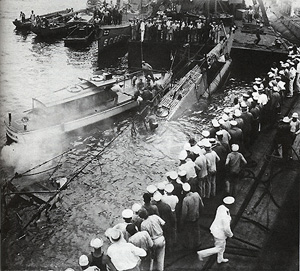|
unable to give any information as to how
many are imprisoned. Their responses to the dots and dashes rapped out
on the outside of the sunken craft have been a series of unintelligible
knocks.
For a second time, Shep snaked a guideline
through the trench. Another four-inch cable was pulled through. Ajax lifted.
The cable broke again.
Shep went under the submarine a third time. The
cable broke a third time.
Shep had been diving for almost twenty-four
hours. Navy doctors worried that he would collapse from exhaustion or
that his heart would fail under the strain.
Shep tried once more. Two things held the
submarine down: one was simply the weight of the flooded craft; the
other, the suction of bottom mud wrapped around the hull. To reduce
the sub's weight, Shep aimed a jet of compressed air into the engine
room. As water and mud boiled to the surface, Ajax began to pull
gently for the fourth time.
Shep sensed the moment was right. He signaled Ajax
to begin lifting in earnest. The bow of the 0-5 began
to rise. From 12:30 to 1:10 P.M., Ajax pulled. Then the
sub's bow broke surface.
Two survivors crawled out after thirty-one
hours of imprisonment: Chief Electrician's Mate Lawrence Brown and Torpedo man
Second Class Henry Breault.
Shep Shreaves demonstrated exceptional skill
and courage. Panama Canal employees have pointed with pride to similar
excellence among many fellow workers. Foremost recognition has been
given to the pilots who board ships, take command, and move them safely
through the canal.
|
|
"Used to be," a pilot said, "a
person who wanted to be a pilot had to have been master of [an
oceangoing] vessel for at least a year and be under 35 years of age.
That meant a young captain-the canal got top performers."
Required qualifications changed in recent
years. The canal began to accept experience as a second or third officer
of a merchant ship or experience as a tugboat captain for five years.
Age rules were waived.

0-5 Surfaces and crew are rescued.
Click Image for a larger view
Information for this
article came from the book Panama's Canal, by Carl R. Olive,
1990 |
|

